Family : Salamandridae

Text © Dr. Luca Tringali

English translation by Mario Beltramini
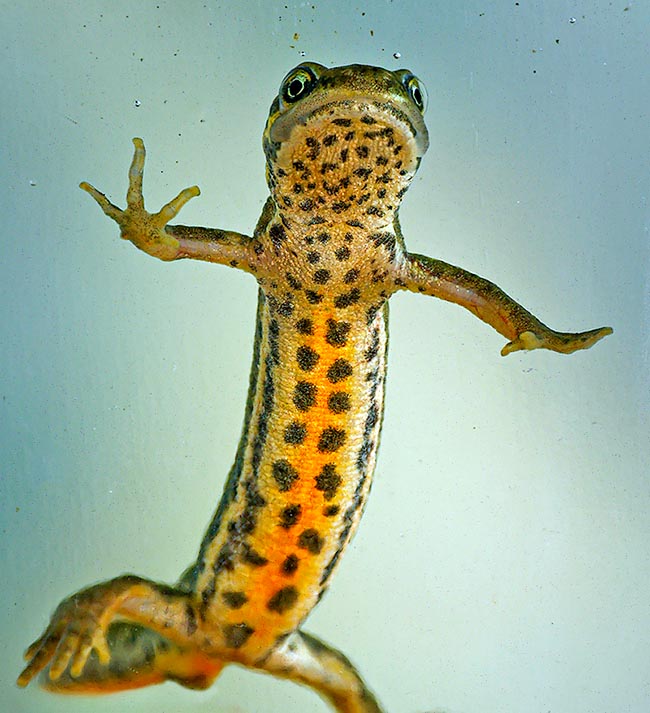
In reproductive time Lissotriton vulgaris can be found in ditches, basins and medium/small puddles © Peter Warne
The Smooth newt or Common newt, Lissotriton vulgaris (Linnaeus, 1758), is an urodelian, or caudate, amphibian, of the family Salamandridae that counts 139 species in 31 genera, with a mainly Holarctic distribution, diffused in eastern and western North America, Europe, western and south eastern Asia, Japan and, marginally, in North Africa.
The amphibians are mostly aquatic and oviparous, even if some terrestrial and ovoviviparous genera do exist.
The generic name, also referred to by the English common name “Smooth Newt”, evokes its smooth skin and its amphibian habits: in fact, it is composed by the two Greek words “λισσός” (lissós), smooth, and “Τρίτων” (Triton) Triton, mythological aquatic deity.
The specific epithet, from the Latin, “vulgaris”, vulgar, of the vulgus, has been universally adopted in the binomial nomenclature to denominate the most known and most diffused species of a genus.
The most recent phylogenetic research have brought to ten the number of the species afferent to this genus, raising to the rank of good species four entities previously considered as subspecies of Lissotriton vulgaris.
Besides the Common newt have been described: Lissotriton boscai, west Iberian Peninsula; Lissotriton graecus, previously subspecies, distributed from south Balkans up to Greece and to south Bulgaria; Lissotriton helveticus, with sub-Atlantic diffusion restricted to Western Europe; Lissotriton italicus, central and southern Italy; Lissotriton kosswigi, previously subspecies, present in Turkey; Lissotriton lantzi, previously subspecies; of western and central Caucasus; Lissotriton maltzani, Portugal; Lissotriton montandoni, Carpathians and Tatra mountains between Poland and Slovakia; Lissotriton schmidtleri, previously subspecies, present in western Anatolia.
Zoogeography
The oldest separations at specific level in the western genus Lissotriton that derived in Lissotriton boscai, Lissotriton helveticus and Lissotriton italicus, still existing in Europe, happened in the Miocene from 23,03 Ma and 5,332 Ma.
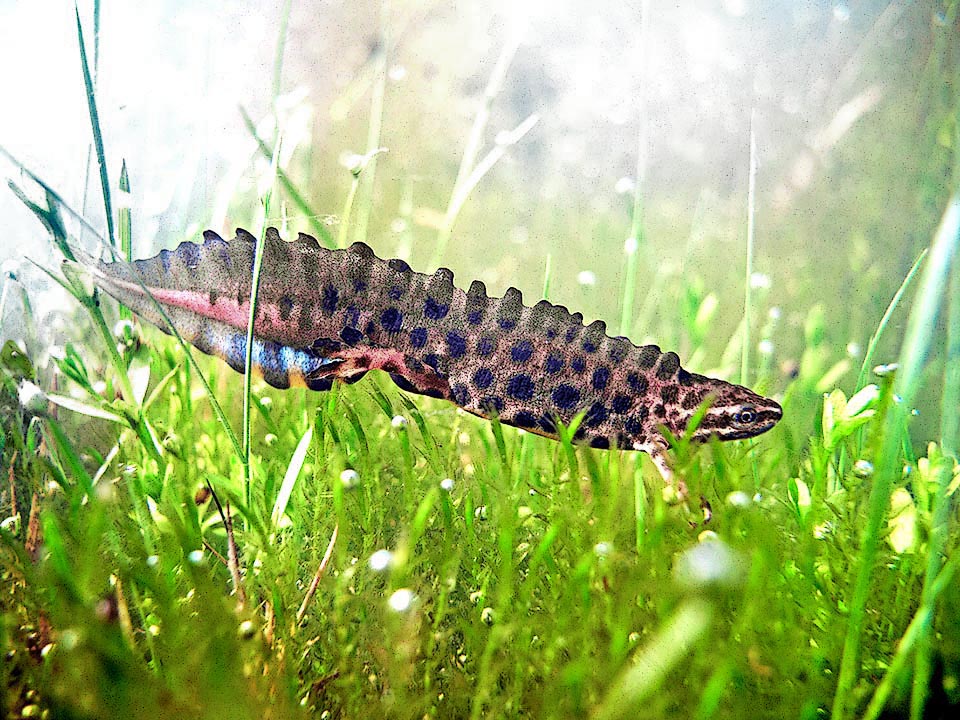
Nominal subspecies male, Lissotriton vulgaris vulgaris, characterized by a serrated dorsal crest and strokes of blue on the tail © Roman Providukhin
Conversely, the majority of intraspecific divergences in Lissotriton vulgaris are relatively recent, and date back to the late Pliocene and middle Pleistocene, between 2,5 million years and 11700 years ago.
Lissotriton vulgaris, with Central Asian European Mediterranean diffusion, from Belgium to west Siberia and from the Scandinavian Peninsula up to Central Italy, and introduced in Australia, stands among the Eurasian amphibians having the widest geographical distribution.
It presents a high degree of genetic variations from the distribution and from the morphology partially overlapped, partly because of the isolation, occured in historical times, of groups of populations who came again in contact more recently, partly because of local adaptations.
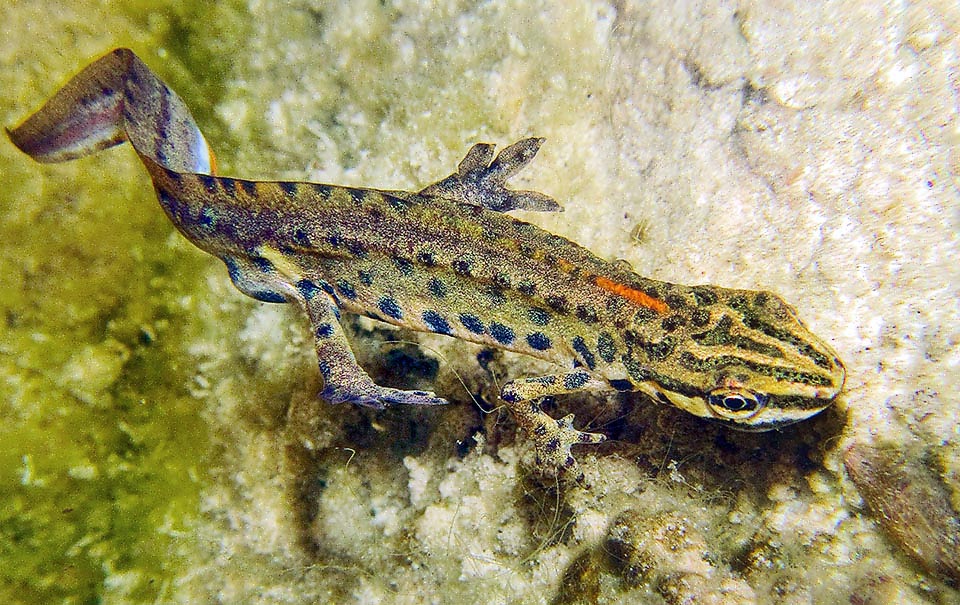
Lissotriton vulgaris meridionalis is common in Italy, it has instead a uniform low crest and the toes of the rear legs conspicuously palmate © Luca Tringali
It seems that the Balkan Peninsula has been the primary source of genetic diversity for the subspecies complex that form the group Lissotriton vulgaris (sensu lato), making possible the survival of the isolated populations during the last glaciation and allowing the subsequent repopulation of central and northern Europe.
The dispersion capacity limited to a radius of 2 km, the tendency of the females of returning to their native sites for the reproduction and, especially, the barriers formed by the ample European wide running waterways have contributed to the isolation of the populations and to the separation in species and subspecies.
The recent phylogenetic research on Lissotriton vulgaris, in the past considered as a single polytypic species on which were afferent seven different subspecies, today recognize at least three of them.
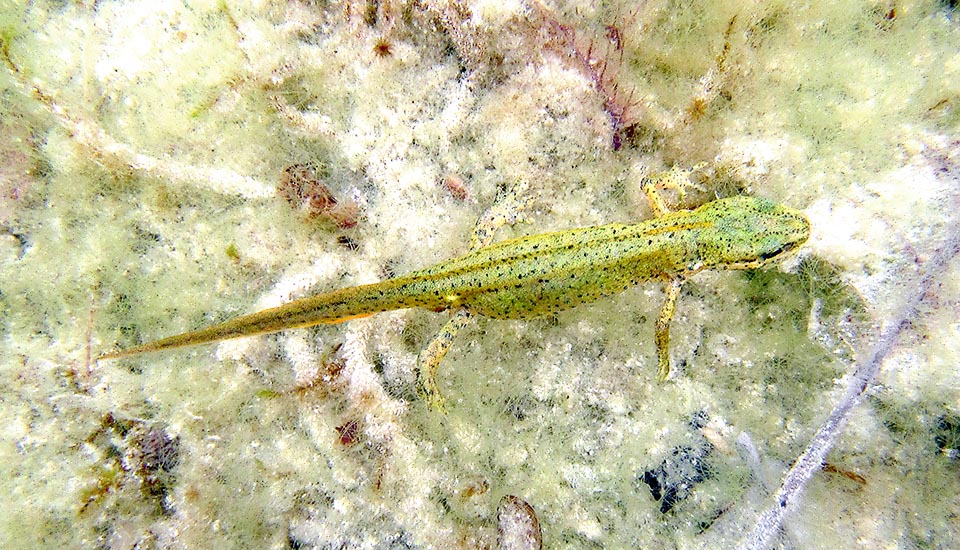
Females are crestless and those of Lissotriton vulgaris meridionalis are studded with black dots on a greenish livery © Luca Tringali
Lissotriton vulgaris vulgaris is the nominal subspecies, known also as Dotted Central-European Smooth Newt, distributed in Europe, (but Spain, Portugal, southern France), Ukraine , Russian Federation and, marginally, in north-eastern Italy.
Lissotriton vulgaris ampelensis is the Rumanian Dotted Smooth Newt, present in the Carpathians and in Transylvania, whose subspecific epithet reminds the basin of the river Ampoi (“Ampoiului” in Rumanian), typical locality of origin; Lissotriton vulgaris meridionalis is finally the Italian Dotted Smooth Newt, distributed in a large part of the Italian territory up to Campania, in Switzerland in the Canton of Ticino, in a good part of Slovenia and part of Croatia.
Ecology-Habitat
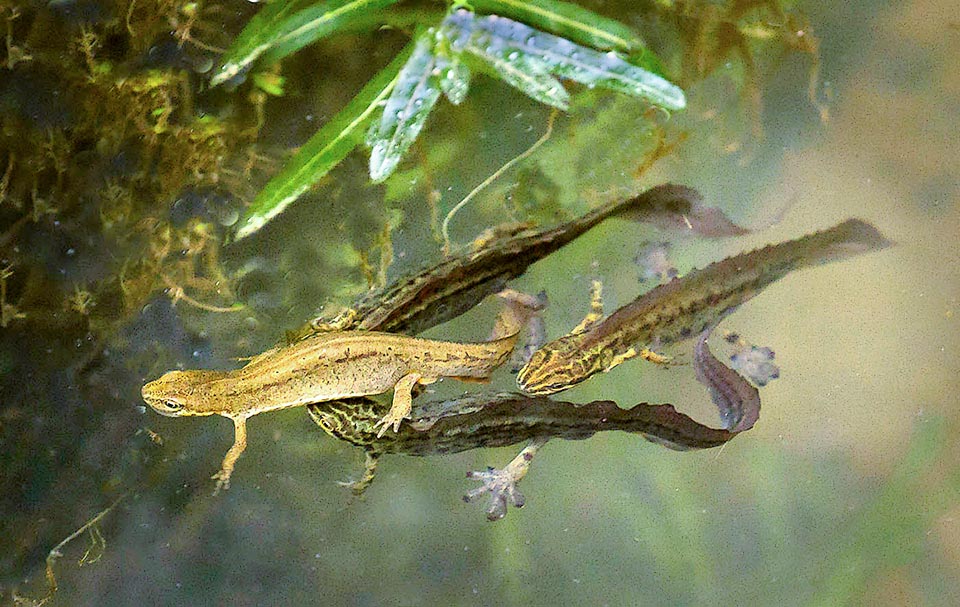
The nominal ones have brown reddish shades. Here one chased by three suitors and it is not excluded that it may accept them all © Peter Warne
Lissotriton vulgaris is a caudate who alternates an aquatic phase with a terrestrial one and stands among the amphibians having an ampler ecological valence as it is present , from the sea level up to more than 3000 m of altitude, able to colonize a vast variety of aquatic environments of natural and artificial origin, usually having no fishes and of moderate depth.
It is found in ditches, lake basins, permanent and temporary puddles. of medium and small size, troughs, artificial basins with still water, and occasionally, even in brackish waters.
It is often found in association with the bigger Triturus carnifex, from which it is occasionally preyed upon. Having in common many ecological characteristics, the two species however frequent different microenvironments: usually, compared to Triturus carnifex, Lissotriton vulgaris prefers the shallower areas of the sites where they live together.
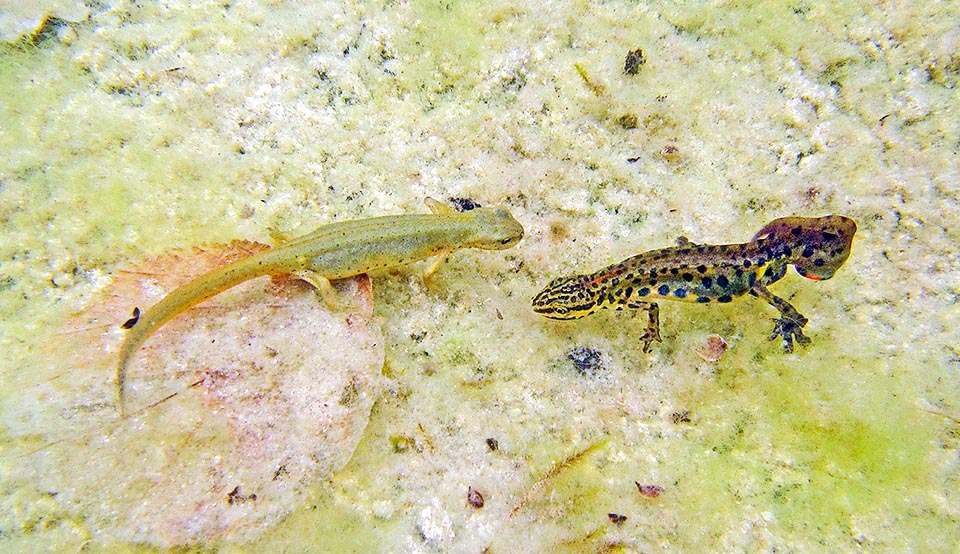
Lissotriton vulgaris meridionalis in wedding parade. It vibrates its tail to spread its olfactory stimuli, the pheromones, towards the female © Luca Tringali
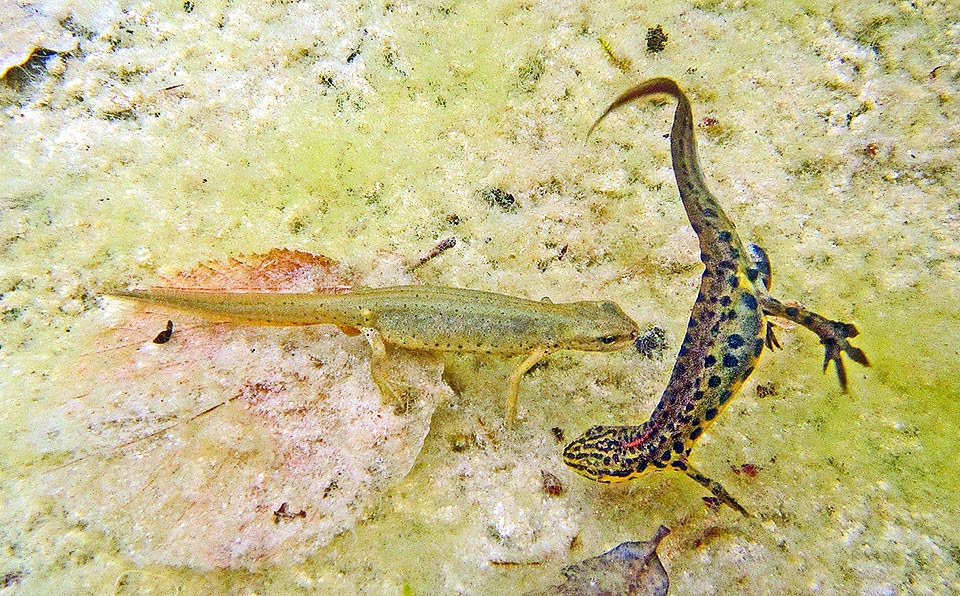
Then wriggles vertically showing the cloaca. If the female touches it with the snout will mean that it accepts the spermatophore, capsule with sperm it will lay on the bottom © Luca Tringali
The most favourable terrestrial environments are formed by sunny areas with a good vegetation cover, mainly in woods adjacent to watercourses (hygrophilous woods) formed chiefly by species of the genera Alnus, Carpinus, Corylus, Fraxinus, Populus, Quercus, Salix, Ulmus, but also in pastures, cultivated fields and in more anthropized areas such as parks and gardens.
The aquatic reproduction sites and the terrestrial wintering places, formed by tree stumps and small cavities between the ground and the rocks, are usually at short distance from each other.
In the continental climate of north and north-eastern parts of the distribution range the period of hibernation extends from November to March, whilst in some southern sites it may be absent or very reduced, with the amphibian remaining active even all the year.
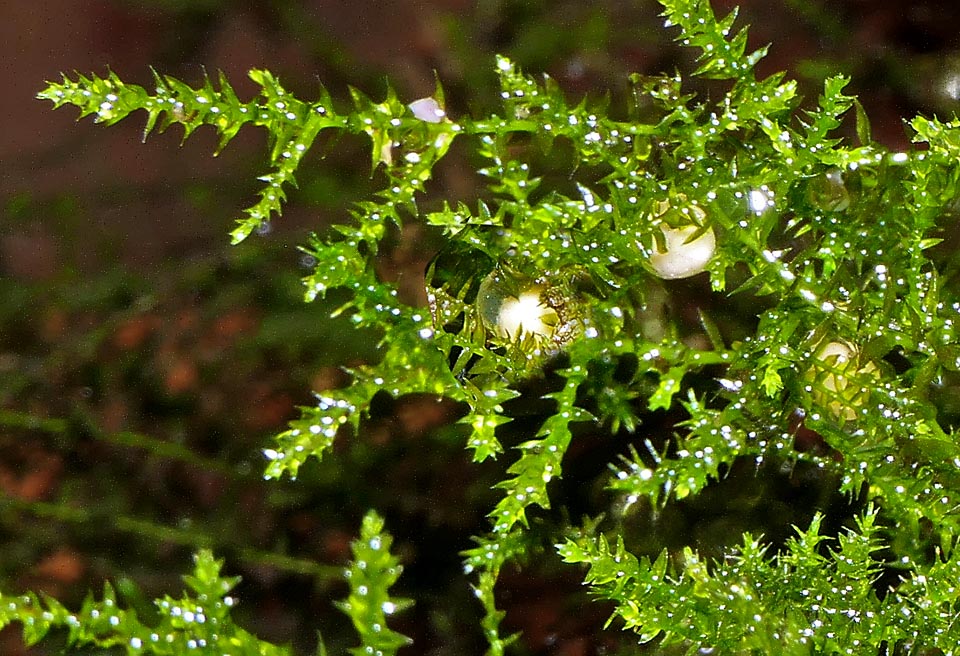
Each female lays 100-300 eggs per season. No larger than 2 mm, they are stuck singly on the aquatic vegetation in order to reduce predation © Luca Tringali
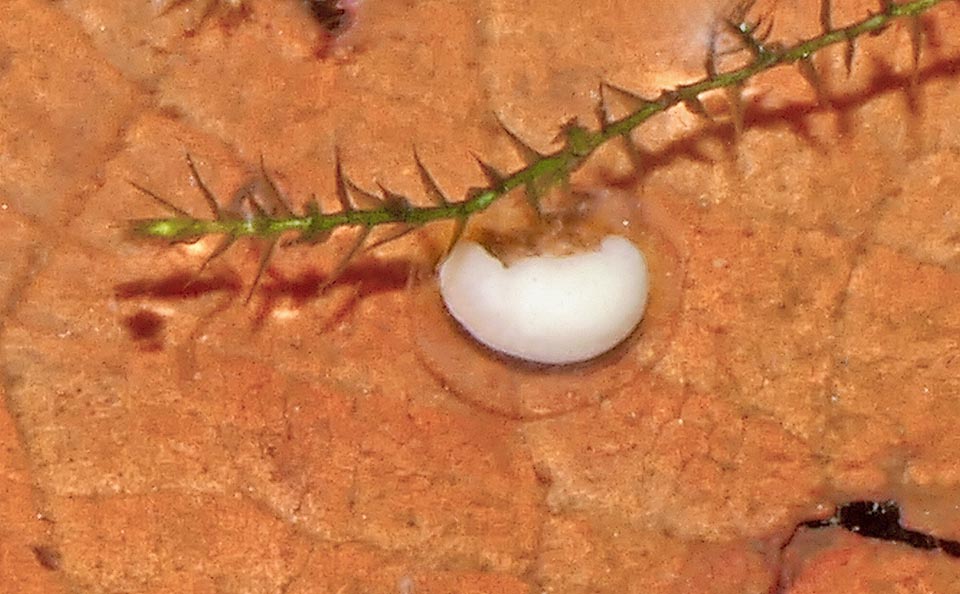
Egg with embryo growing in its jelly mass. They hatch when 10-20 days old depending on the temperature of the water © Luca Tringali
Lissotriton vulgaris spends most of its time on the ground, whilst it moves to the aquatic phase only during the period of reproduction. The adults in terrestrial phase are active during the night hours, going out in the daylight hours only during the rains and immediately after them; larvae and adults in aquatic phase are active during the day as well as during the night.
Lissotriton vulgaris has a generalist diet. The larvae feed on microcrustaceans, especially copepods and ostracods; then, growing, the food spectrum broadens and includes species of bigger sizes such as bivalves of the family Sphaeridae, gastropods Lymnaeidae, and larvae of insects, whilst the plankton is usually ignored.
The Smooth Newt stops feeding during the phase of passage from the aquatic larval stage and the transfer to the mainland, as the newly metamorphosed juveniles feed exclusively on the ground.
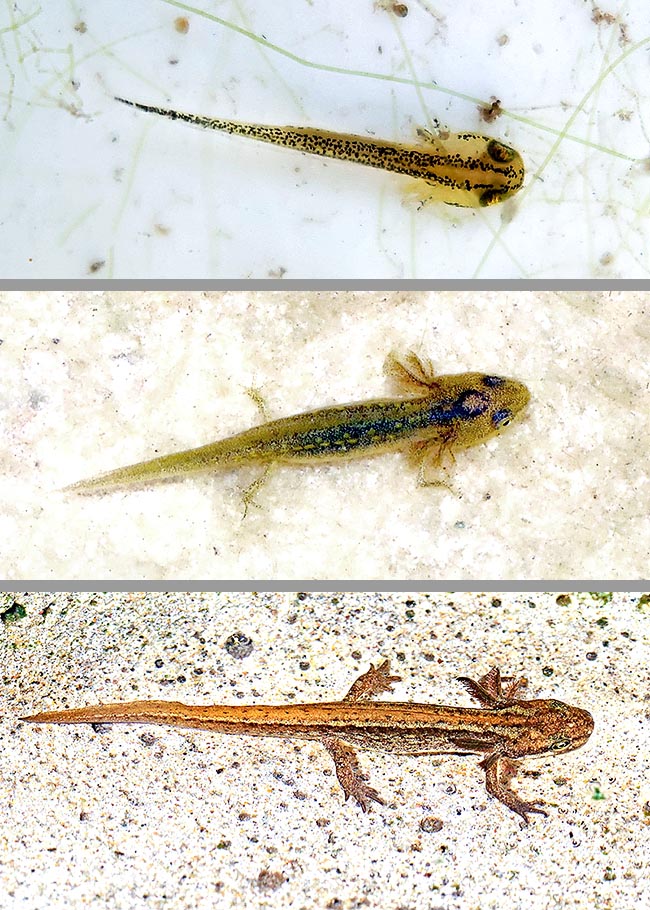
The larvae grow and usually metamorphose when about 25-30 mm long. Above a very young one, then of medium size and finally a now large specimen. From above © Victor Heng © Luca Tringali © Roger Wasley
The diet of the adults is considerably broader and includes annelids, gastropods, isopods, mites, spiders, springtails, beetles, lepidoptera, diptera, odonates.
During the aquatic phase the adults also consume the larvae of the same groups just mentioned and the eggs of other amphibians; also cannibalism, mainly in the form of oophagy, is considered in the adult diet.
The larvae of Lissotriton vulgaris form a prey for some aquatic insects, whilst the adults are preyed upon by many vertebrates, especially fishes, reptiles of the genus Natrix, and birds, in both phases, aquatic and terrestrial.
Morphophysiology
Lissotriton vulgaris is a small newt that reaches averagely 9-11 cm in the subspecies Lissotriton vulgaris vulgaris and little less in Lissotriton vulgaris meridionalis, with females usually bigger than the males.
The skin is smooth during the aquatic phase whilst may be slightly grainy or velvety in the terrestrial phase animals and the length of the tail is almost the same as the length of the head-body. The head has some dark longitudinal streaks, the dorsal and lateral surface of the body may be brown, greyish, yellowish or greenish, whilst the belly appears white, pale yellow or orange, mainly in the rutting animals, and sides and belly present dark, almost black, points.
The males are smaller than the females, have a narrower body, the trunk shorter, the dorsal and ventral black spots bigger, the tail proportionally longer, the colour of the back often darker.
The vertebral crest begins on the nape in the males in aquatic phase, and a little further in the females where it can reach a maximum height of 2 mm, continuing up to the tail.
During the reproductive season Lissotriton vulgaris displays an even more vident sexual dimorphism with the male exhibiting a toothed mid-dorsal crest, bluish longitudinal bands on the lateral surfaces of the tail, and at times on the body, and the cloaca (the only duct carrying on at the same time digestive, urinary and reproductive functions) considerably more swollen, dilated and protruding, with very elongated cloacal fissure.
Some characters that appear during the reproductive season also allow to easily distinguish at least the males of the two subspecies Lissotriton vulgaris vulgaris and Lissotriton vulgaris meridionalis.
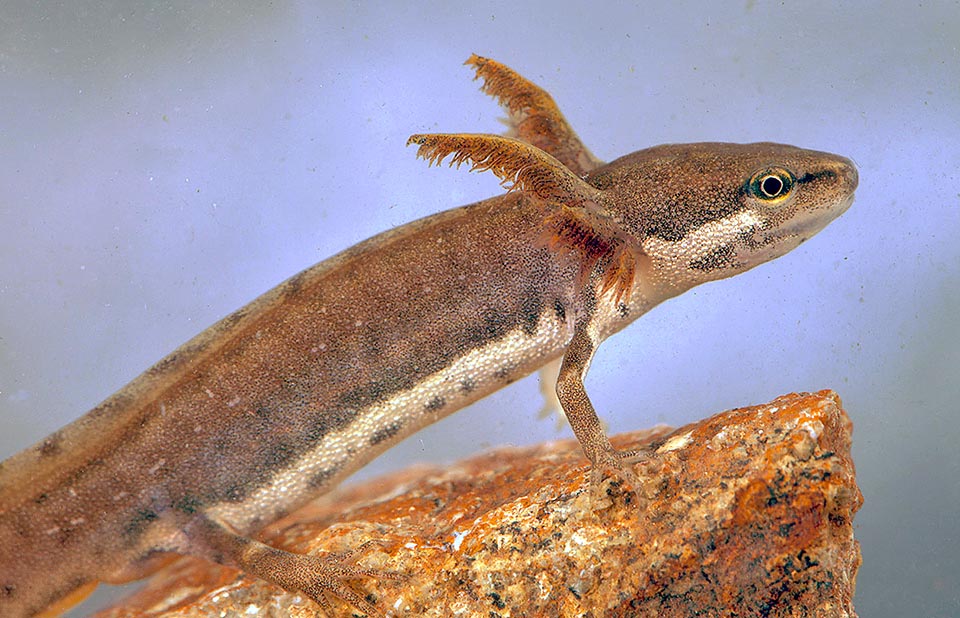
If the water temperature is low, population modest and food abounds, sime mature adults, called neotenic, decide to remain in water thus keeping gills © Frank Deschandol
In the nominal subspecies the colouring is particularly lively, with very evident spots and small points on the body, the dorsal crest is very high, with serrated and wavy edge, the rear legs have rather reduced lobed digital membranes, also during the nuptial period.
In the Italian Dotted Smooth Newt the dorsal crest is relatively low, usually smooth or at most slightly wavy, the colouring is less lively and the rear legs have fairly well developed digital lobed membranes. More difficult is the distinction at morphological level of the Rumanian subspecies Lissotriton vulgaris ampelensis where the dorsal crest of the male, usually having smooth and straight edges, begins in the occipital region and culminates with its highest point over the cloaca.
Ethology-Reproductive Biology
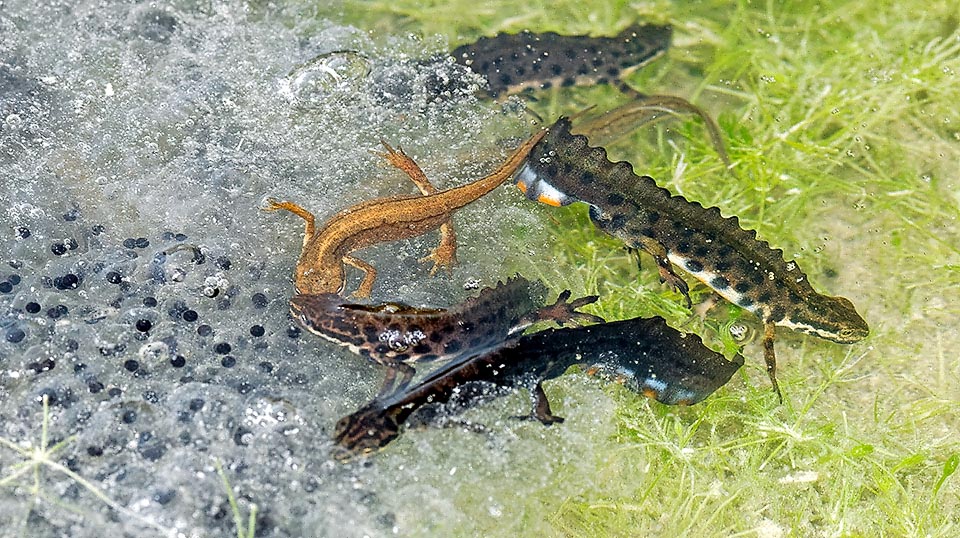
Adult Lissotriton vulgaris vulgaris in the aquatic phase who between courtships prey on frogs legs © Jan Fischer Rasmussen
In the temperate oceanic climate of western Europe Lissotriton vulgaris can start its reproductive migration towards the aquatic sites in January, but in populations of high altitudes the adults may delay the entry onto the water to the month of April. Especially at low altitudes and at low latitudes, the migration to the water and the development of the seasonal secondary sexual characters can begin in late summer or in early autumn, to continue for about 60 days.
The reproduction takes place in an aquatic environment, just after the period of wintering and the deposition is preceded by a complex courtship ritual, behaviour that, in some of its elements, differs from one subspecies to the other.
During the nuptial dance the male of Lissotriton vulgaris tries to attract the female displaying the colouring of the sides and sniffing at its cloaca.
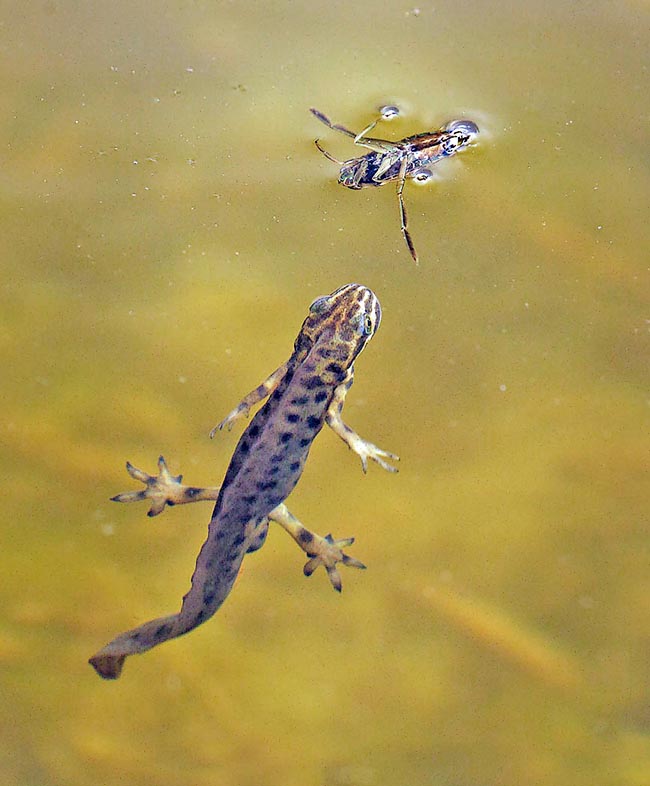
Naturally they don’t forget the aquatic insects like this backswimmer © Peter Warne
It adopts therefore a typical behaviour, called “tail fanning”: makes the tail vibrate against its body, at times lashing it violently, thus diffusing olfactory stimuli, the pheromones, towards the female.
This phase may be repeatedly interrupted by the male who, wagging the tip of its tail, assumes a vertical position with respect to the female and presents its cloaca, at times hitting her on the head.
In the final phase it walks away, always wagging its tail. If the female is receptive, she will follow him and will touch its cloacal region with the snout, in order to induce it to deposit one spermatophore on the bottom that then it picks up with the cloacal lips.
Often the nuptial dance is interrupted by other males that try to get the attention of the female.
In Lissotriton vulgaris meridionalis the phase of olfactory stimulation is particularly long in respect to the nominal subspecies, more conspicuous and with more lively colours, and in which acquire particular importance the visual stimuli.
The eggs are fertilized inside the body and the progeny of one single female usually descends from more than one male.
The number of eggs laid by one single female per reproductive season varies from 100 to 300. Of vaguely oval shape and with a maximum diametre of 2 mm about, the eggs are laid singly or in small groups in the aquatic vegetation with anti-predatory purposes, and hatch after 10-20 days, depending on the temperature.
The larvae perform their metamorphosis for the passage from the terrestrial phase in about three months, once reaching the length of 25-30 mm, even if in some cases they may winter in water.
The sexual maturity is reached at the age of two or three years, and the expected lifespan is of 6-14 years.
Like in other species of amphibians, also in Lissotriton vulgaris are known cases of neoteny, phenomenon for which in some adult and mature individuals remain some physiological and morphological characteristics typical to the larvae, and whose most evident demonstration is the permanence of the gill apparatus.
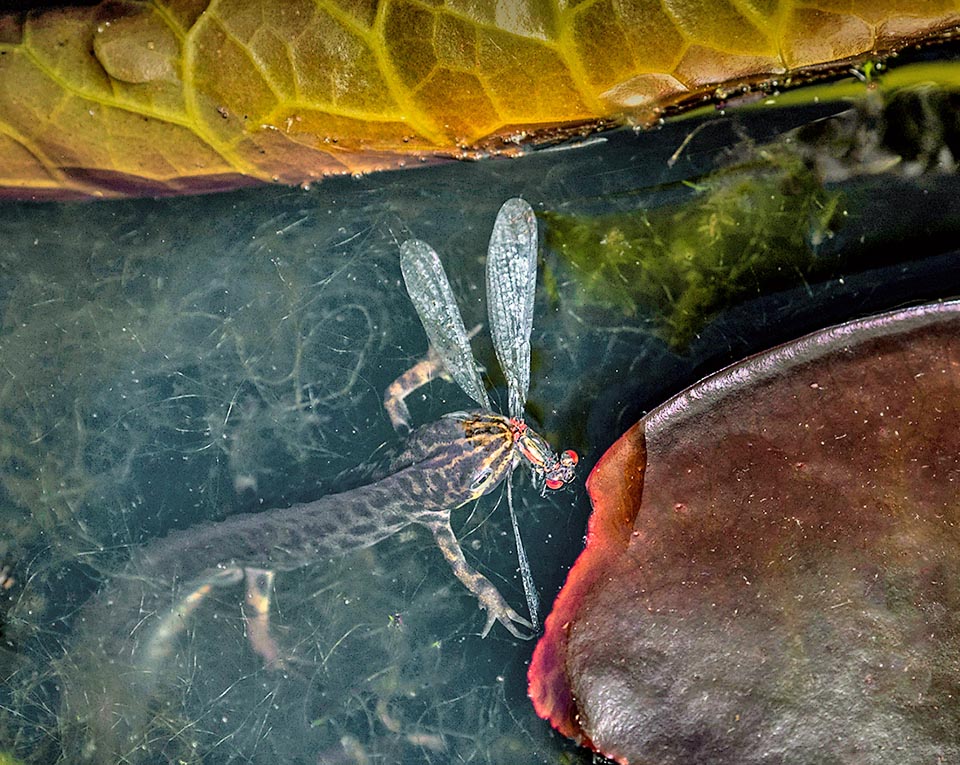
Here grabbed a dragonfly. On the mainland the diet is ampler with annelids, gastropods, isopods, mites, spiders, springtails and insects © Peter Warne
This phenomenon concerns only a limited number of individuals and does not seem to be caused genetically, but rather by some environmental and ecological characteristics like the low temperature of the water, a low density of population and the abundance of aquatic prey.
Research conducted on Lissotriton vulgaris meridionalis of areas close to the sea level indicate that the maximum concentration of the newts in the aquatic phase happens in the period between March and April, with temperatures included between 1-19 °C.
In stable environments such as troughs the minimum time spent in water is averagely of 42 days, whilst in less stable environments like the temporary water pools the number of days of stay reduces to 15.
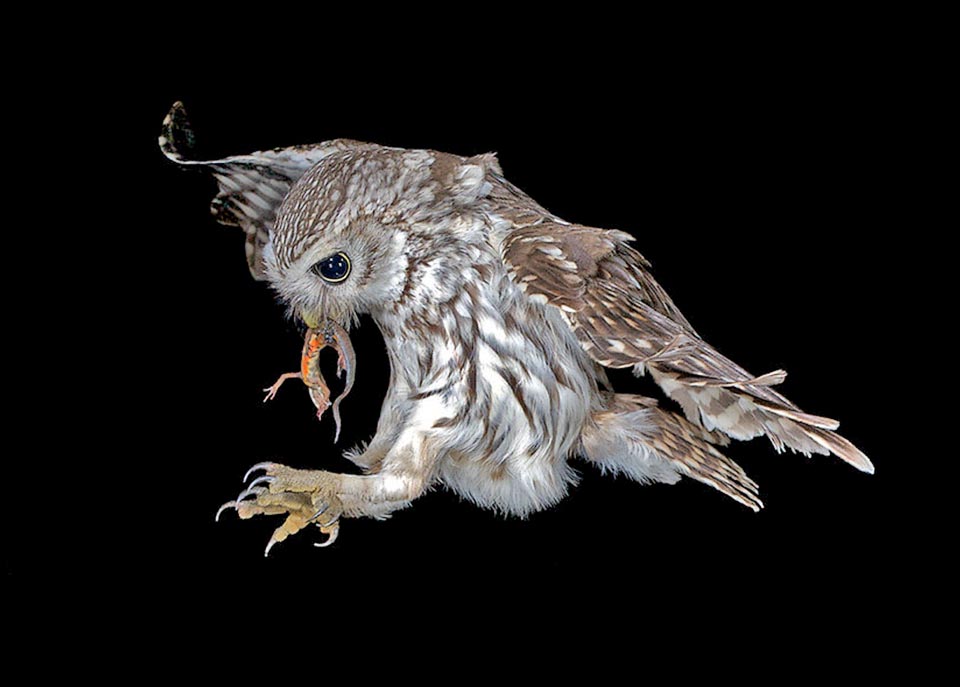
Lissotriton vulgaris is in turn preyed upon by fishes, snakes, waterfowls, ravens and raptors like this owl (Athene noctua) © Frank Deschandol
The “sex ratio” in the aquatic phase is close to 1:1, with variable oscillations during the reproductive season: the presence of the males is bigger in the first part of the season with a gradual increase in the number of females.
Highly adaptable species, Lissotriton vulgaris does not seem to be particularly threatened, and consequently is classified “LC, Least Concern” in the IUCN Red List of the endangered species.
Despite this, it suffers from the same risks usually recognized for the other species of newts: mortality due to the car traffic during the transfers between the terrestrial and aquatic phases, introduction of fishes in the reproduction locations, drinking troughs cleaning operations during the reproductive phase.
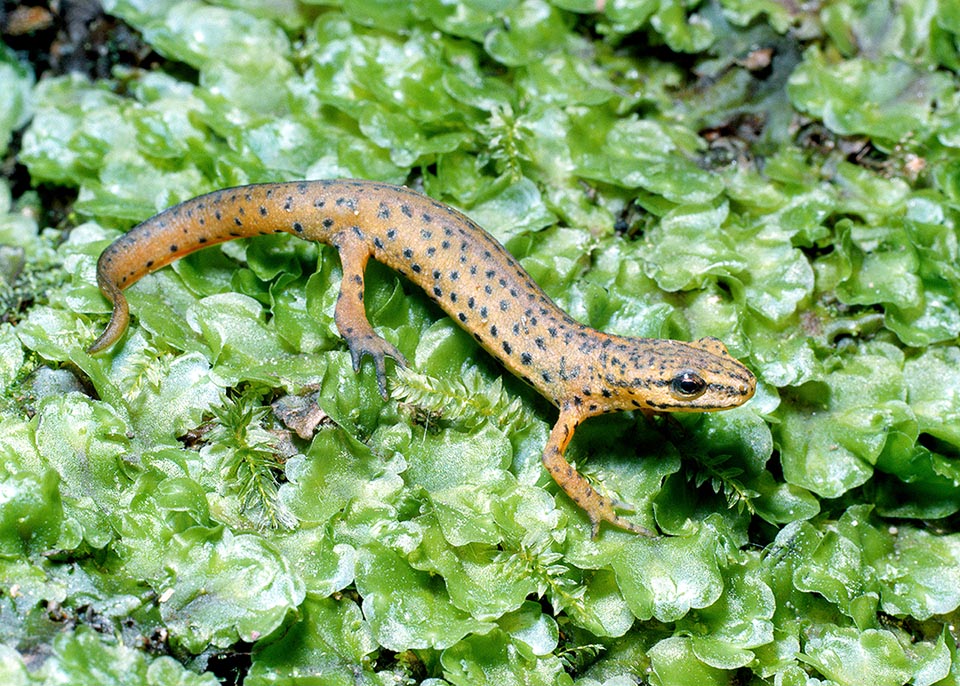
Juvenile metamorphosed on mainland exploring its new world. Sexual maturity is reached when two or three years old, and lifespan is of 6-14 years © Giuseppe Mazza
Its ability to adapt is such that, introduced in Australia through illegally imported specimens, it has successfully settled in the southern part of this continent where, previously, the only order of amphibians present was that of the Anura.
The potential ecological implications of this invasion are big because the Lissotriton vulgaris competes with the native frogs. Moreover, as the climate in south-eastern Australia is similar to that of its area of origin, the Smooth Newt has the potential for spreading in most of southern Australia and in Tasmania.
Finally, like for other species of amphibians that colonize ecologically unstable environments, it has been noted in Lissotriton vulgaris a high annual mortality, even of 50%, with remarkable annual numerical fluctuations in relation with the reproductive success and the incidence of predation on the populations.
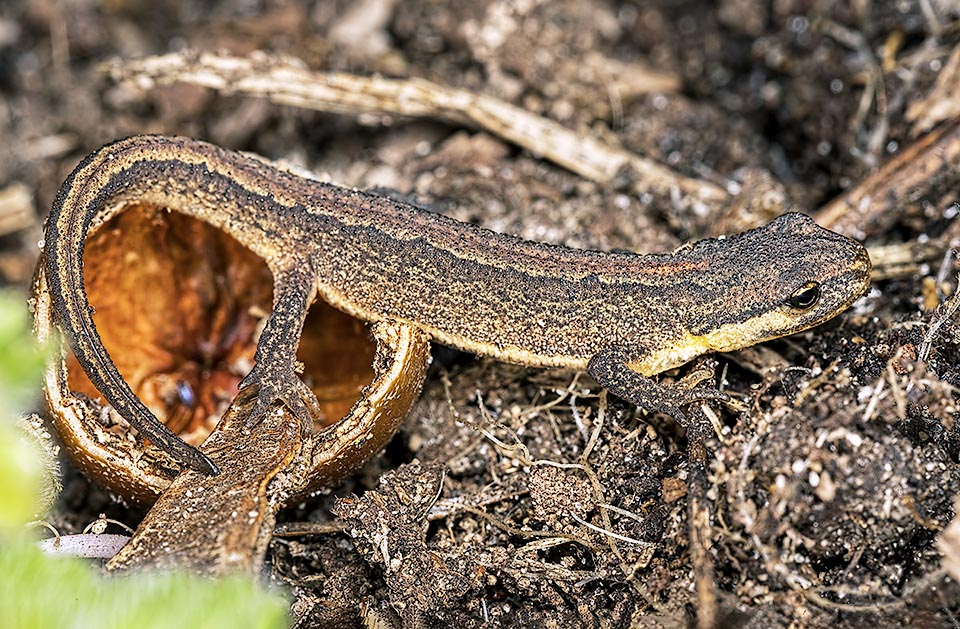
Then the skin gets wrinkled and colour more mimetic. It will shelter to spend winter under the stump of a tree or some soil cavity waiting for the nice season © Jan Coolen
Synonyms
Lacerta vulgaris Linnaeus, 1758; Lacerta aquatica Linnaeus, 1758; Lacerta palustris Linnaeus, 1758; Triton palustris Laurenti, 1768; Triton parisinus Laurenti, 1768; Salamandra exigua Laurenti, 1768; Gecko triton Meyer, 1795; Gecko aquaticus Meyer, 1795; Salamandra taeniata Schneider, 1799; Salamandra palustris Schneider, 1799; Salamandra punctata Latreille, 1800; Lacerta triton Retzius, 1800; Salamandra elegans Daudin, 1803; Triton (Geotriton) exiguus Bonaparte, 1832; Lissotriton punctatus Bell, 1839; Molge vulgaris Boulenger, 1882; Triton meridionalis Schreiber, 1912; Triturus vulgaris Dunn, 1918; Triturus (Palaeotriton) vulgaris Bolkay, 1927; Spelerpes ferrugineus Lazzarini, 1930; Lissotriton vulgaris García-París, Montori, and Herrero, 2004; Lophinus vulgaris Litvinchuk, Zuiderwijk, Borkin, and Rosanov, 2005.
→ For general notions about Caudata please click here.
→ To appreciate the biodiversity within the SALAMANDERS please click here.
